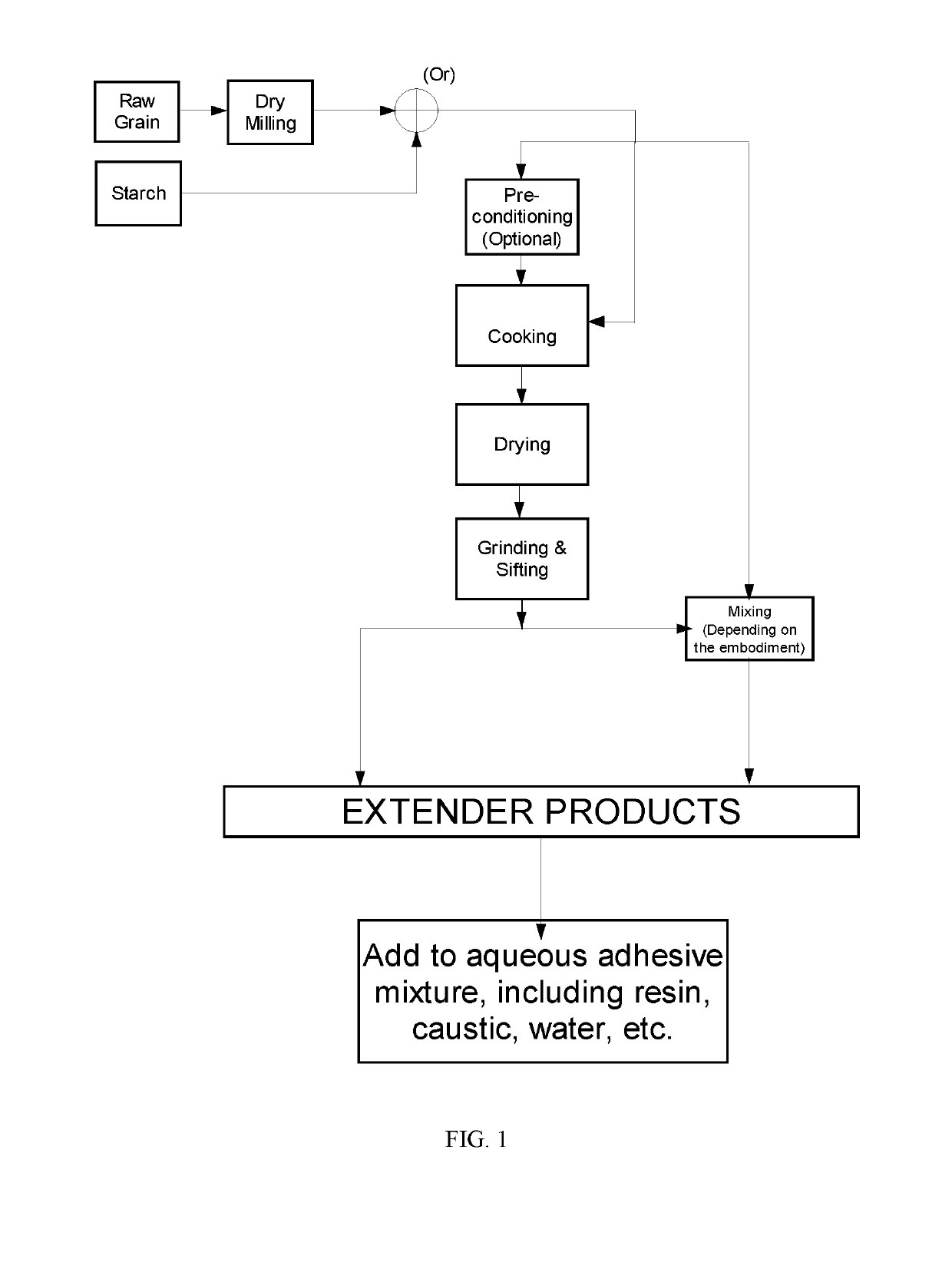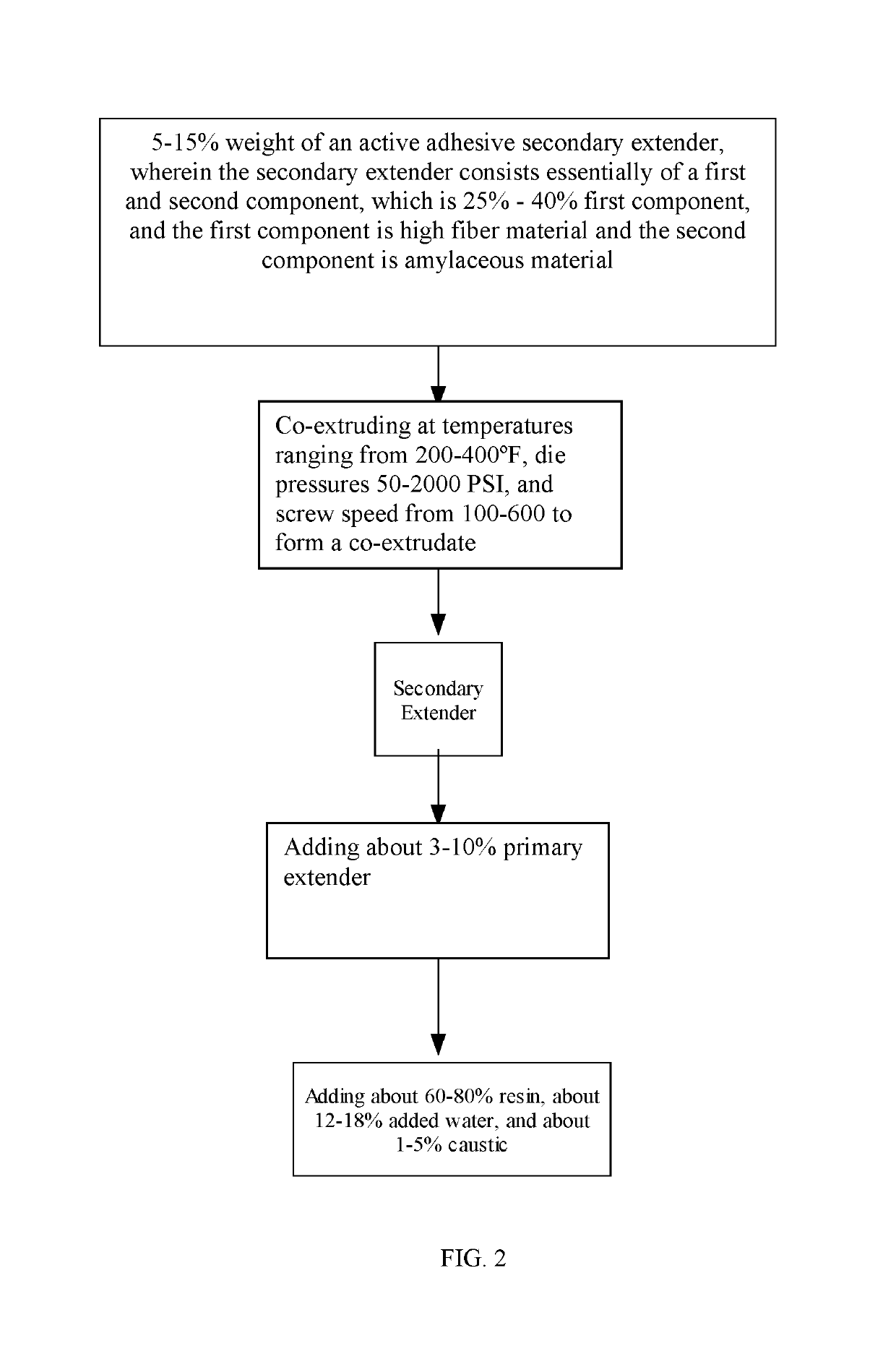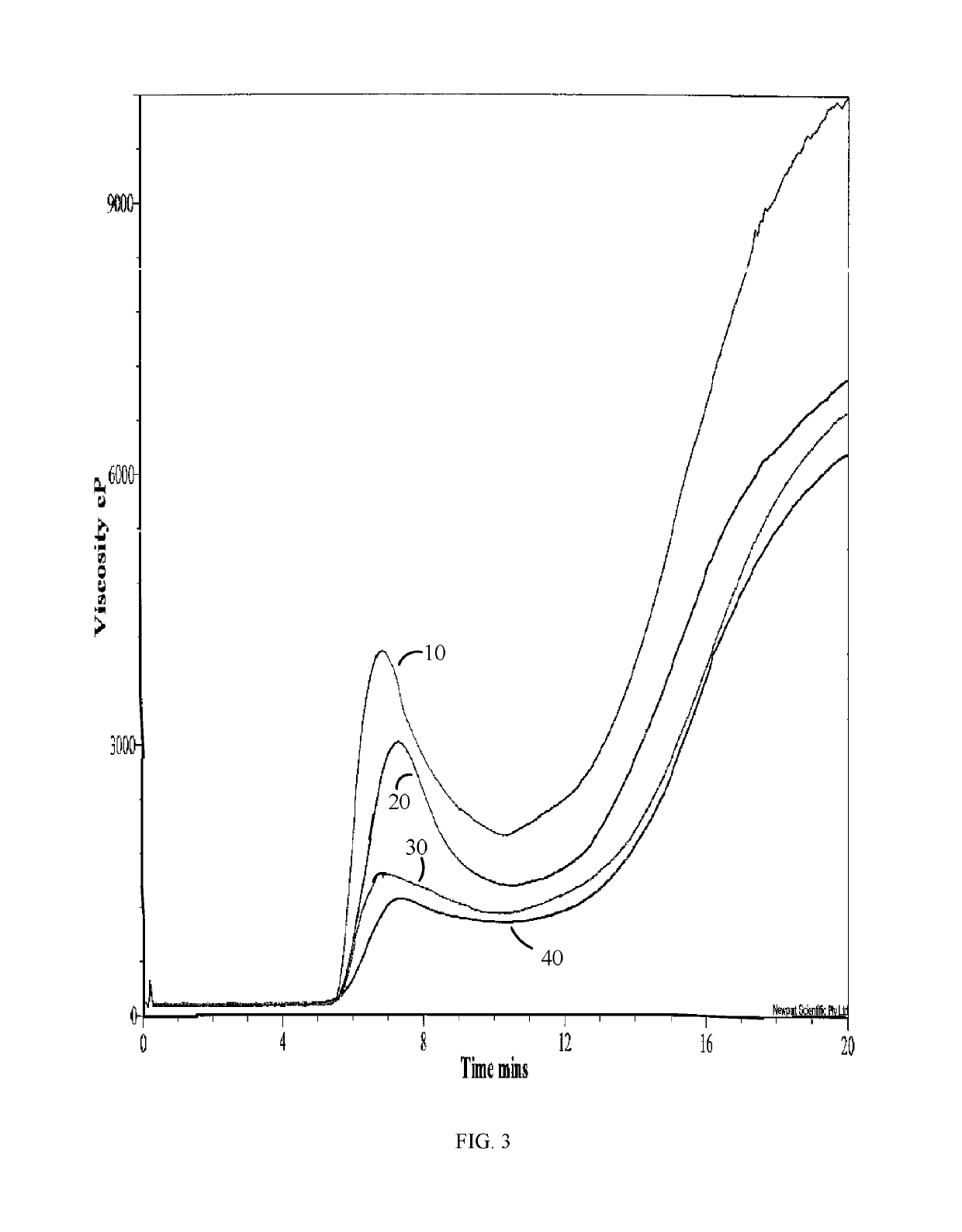Composite wood adhesive
a wood adhesive and composite technology, applied in the direction of adhesives, non-macromolecular adhesive additives, adhesive types, etc., can solve the problems of poor viscosity, achieve good viscosity, improve viscosity, and improve the effect of adhesive performan
Active Publication Date: 2019-04-30
PLY BOND CHEM & MILL SUPPLIES
View PDF41 Cites 4 Cited by
- Summary
- Abstract
- Description
- Claims
- Application Information
AI Technical Summary
Benefits of technology
The patent describes a new method for making a substance that can be used to manufacture composite wood products. The method involves using a special adhesive made from high pH PF paste, which can be extended by adding soy bean, wheat, or corn flour. This new method involves using a mixture of heat moisture treated amylaceous cereal grain flower or legume flour with a high fiber by-product. This mixture is heated and extruded to create a secondary extender that has good viscosity, stability, and pot life. The secondary extender can be used to improve the adhesiveness of the adhesive. The heat moisture treatment involves cooking the materials to create a range of degraded or denatured particles that impart the required viscosity and stability to the adhesive. The method uses extrusion to provide optimal mechanical energy and minimum thermal energy input to produce the desired bulk properties. The moisture content of the starting materials can be adjusted, and the pressure and temperature at the die plate can be controlled. The heat / moisture treated product exits the die orifice with reduced moisture content, and further drying may not be necessary.
Problems solved by technology
This is unexpected because the fiber in high fiber co-products from cereal grain and legumes, and legume proteins by themselves typically swell to excess, producing pastes using these materials in either a filler, or secondary extender exhibiting very poor viscosity, and viscosity control and stability in the high pH environment of PF resin based paste formulas.
Method used
the structure of the environmentally friendly knitted fabric provided by the present invention; figure 2 Flow chart of the yarn wrapping machine for environmentally friendly knitted fabrics and storage devices; image 3 Is the parameter map of the yarn covering machine
View moreImage
Smart Image Click on the blue labels to locate them in the text.
Smart ImageViewing Examples
Examples
Experimental program
Comparison scheme
Effect test
example 1
[0074]
WeightPercentResin74.42Water11.64Caustic3.00Primary Extender4.16Secondary extender6.23Soda Ash0.56
example 2
[0075]
WeightPercentResin65Water17.2Caustic3Primary Extender6Secondary extender9Soda Ash0.56
example 3
[0076]
WeightPercentResin65Water17.2Caustic3Primary Extender4.7Secondary extender9.73Soda Ash0.5
the structure of the environmentally friendly knitted fabric provided by the present invention; figure 2 Flow chart of the yarn wrapping machine for environmentally friendly knitted fabrics and storage devices; image 3 Is the parameter map of the yarn covering machine
Login to View More PUM
| Property | Measurement | Unit |
|---|---|---|
| temperatures | aaaaa | aaaaa |
| pH | aaaaa | aaaaa |
| viscosities | aaaaa | aaaaa |
Login to View More
Abstract
An improved composite wood adhesive extender, a method of producing such extender, and an adhesive mixture including this extender are provided, wherein the extender has performance satisfactory to the manufacturing needs of composite and plywood products, while also extending the adhesive at a reasonable cost. The adhesive mixture may have a primary and secondary extender. The primary extender is composed of a wood-based product. The secondary extender may be an amylaceous material comprising 100% uncooked flour or starch, or an amylaceous material comprising 100% uncooked flour or starch blended with a high fiber by-product. Alternatively, the secondary extender may be pre-gelatinized flour or starch and a mixture of pre-gelatinized flour or starch with flour comprising an advantageous quantity of raw starch. The secondary extender may substitute for about 25-40% of the primary extender on about a 1:1 ratio basis.
Description
CROSS REFERENCE TO RELATED APPLICATIONS[0001]This application is a continuation-in-part of U.S. patent application Ser. No. 14 / 614,685, filed Feb. 5, 2015, which is a continuation-in-part of U.S. patent application Ser. No. 13 / 420,059, filed Mar. 14, 2012, now abandoned, which is a divisional of U.S. patent application Ser. No. 12 / 456,373, filed Jun. 16, 2009, now issued as U.S. Pat. No. 8,293,821. All the above applications are incorporated herein by reference in their entirety as if fully set forth herein.FIELD OF THE INVENTION[0002]The invention relates generally to physically modifying mixtures of high fiber materials derived from hulls of cereal grain and legumes, and amylaceous materials through heat moisture treatment using pressure (shear) and heat. The goal is to modify these materials for use as secondary extenders in high pH composite wood products such as phenol-formaldehyde based adhesives.BACKGROUND OF THE INVENTION[0003]Composite woods products may be described as fal...
Claims
the structure of the environmentally friendly knitted fabric provided by the present invention; figure 2 Flow chart of the yarn wrapping machine for environmentally friendly knitted fabrics and storage devices; image 3 Is the parameter map of the yarn covering machine
Login to View More Application Information
Patent Timeline
 Login to View More
Login to View More Patent Type & Authority Patents(United States)
IPC IPC(8): C09J11/04C09J9/00C09J11/08C09J161/06C09J103/02C08L99/00
CPCC09J161/06C09J11/08C09J11/04C09J9/00C08L97/02
Inventor TILLMAN, DONALD N.
Owner PLY BOND CHEM & MILL SUPPLIES
Features
- R&D
- Intellectual Property
- Life Sciences
- Materials
- Tech Scout
Why Patsnap Eureka
- Unparalleled Data Quality
- Higher Quality Content
- 60% Fewer Hallucinations
Social media
Patsnap Eureka Blog
Learn More Browse by: Latest US Patents, China's latest patents, Technical Efficacy Thesaurus, Application Domain, Technology Topic, Popular Technical Reports.
© 2025 PatSnap. All rights reserved.Legal|Privacy policy|Modern Slavery Act Transparency Statement|Sitemap|About US| Contact US: help@patsnap.com



